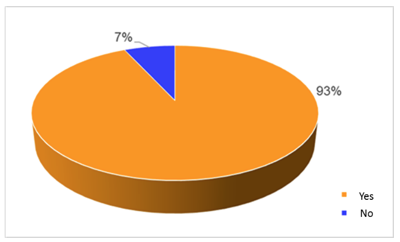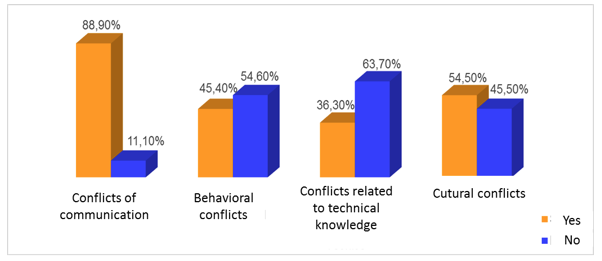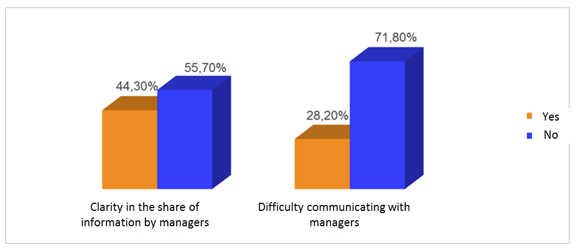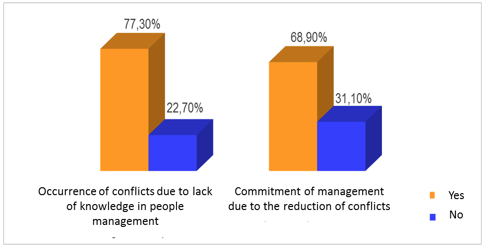

Vol. 38 (Nº 07) Año 2017. Pág. 27
Manoel Mariano Neto da SILVA 1; Antônio Carlos Gardel de Freitas CASTRO 2; Bruno da Cunha FREIRE 3; Hugo Leonardo Pontes NUNES 4; Manoel Inácio Almeida FERNANDES 5; Mauro José da Silva FILHO 6; Adriano David Monteiro de BARROS 7
Recibido: 03/09/16 • Aprobado: 29/09/2016
ABSTRACT: The construction sector has grown significantly in the recent years, expressively contributing to the social and economic development of the country. However, despite all the advances already acquired there are still many weaknesses to be improved. Thus, this work aims to analyze through the researches performed in the construction sites, the most varied types of conflicts that could occur at the construction site, about the employees and managers opinions. Therefore, it was used a quantitative approach, applying two types of questionnaires, containing only closed questions. At first, it was applied to 38 workers in the construction sector. Far along, it was interviewed more 12 managers. In addition, it was accomplished a bibliographical study with the construction management team, teamwork and interpersonal relationships. Thereby, it appears that there are many obstacles to overcome, including the difficulties in maintaining good relations in the workplace. Thus, it can be conclude that one of the biggest challenges is related to the people management, since managers do not have a previous training that includes the social issues related to the work environment. All these factors contributes to the rise of conflicts, which are commonly associated with cultural disagreements, behavioral, communication and even the expertise of the area. Therefore, it appears that the people management needs to go beyond the interpersonal relations protocols and create mechanisms to identify the needs of workers as well as be able to finish the disruptions resulted from daily work. |
RESUMO: O setor da construção civil cresceu de forma significativa nos últimos anos, contribuindo expressivamente para o desenvolvimento social e econômico do país. Mas, apesar de todos os avanços já adquiridos ainda existem muitas fragilidades a serem aperfeiçoadas. Mediante tais discussões, este trabalho tem por objetivo analisar através das pesquisas realizadas nos canteiros de obra, os mais diversos tipos de conflitos gerados na construção civil, na opinião dos colaboradores e gestores. Para tanto, utilizou-se uma abordagem quantitativa a partir das aplicações de dois tipos questionários constituídos por perguntas fechadas. No primeiro momento abordou-se 38 operários do setor da construção civil. Posteriormente, foram abordados 12 gestores. Além disso, foi realizado um estudo bibliográfico acerca da gestão de equipes na construção civil, trabalho em equipe e relações interpessoais. Verifica-se que há muitos obstáculos a serem superados, dentre eles, as dificuldades em manter boas relações nos ambientes de trabalho. Nesse sentido, percebe-se que uma das maiores fragilidades deste setor está atrelada a gestão de pessoas, visto que os gestores não possuem uma formação que englobe com precisão as questões sociais relacionadas ao ambiente de trabalho. Todos esses fatores desencadeiam o surgimento de conflitos, que comumente estão associados às discordâncias culturais, comportamentais, comunicativas e até mesmo aos conhecimentos técnicos da área. Portanto, constata-se que a gestão de pessoas precisa ir além dos protocolos das relações interpessoais e criar mecanismos que identifiquem as necessidades dos trabalhadores e que sejam capazes contornar as conturbações decorrentes do cotidiano profissional. |
The construction site includes all works and production services. Nevertheless, it is included all the activities related to the planning and project design, and the implementation, maintenance and restoration works in different segments such as buildings, roads, ports, airports, navigation channels, tunnels, installations gross, sanitation works, foundations and land in general.
This sector has gained a great prominence in the national market currently because of its growth in all the Brazil regions. As a reflection of the advances made, the construction industry is going through a series of technological innovations that has been improving the building techniques, tools and equipment, enabling higher profitability and quality of service.
However, despite all advances there is still a long road to be traveled, because there are many weaknesses to be improved. Among them, we can mention the difficulties of communication and the lack of good relationships in the workplace. All these aspects can be potential major threats to the full development of service providers, since they contribute to the reduction of labor income indexes and consequently interfere on the quality of the activities performed by employees.
It is emphasized that communication is the exchange of information, ideas and feelings, a process that keeps individuals in permanent contact providing interaction (LOMBARDI, 2010). Based on the author's statements, the necessity to maintain a balanced communication is necessary, since it is responsible for the interaction between employees, which could spoil the training and good performance of work teams.
Thus, this work aims to analyze the various types of conflicts generated in the construction field, through the opinion of employees and managers. Therefore, it is necessary to identify the characteristics of the relationship between the construction managers and their employees; thus, presenting the main problems faced by the managers; analyze employee satisfaction about the methods implemented for the work teams and identify ways to improve interpersonal relations at work.
As Carvalheiro (2011) said, the people management is a very recent issue. The author states that until the nineteenth century the closest to the reality that was practiced were industrial relations and personnel management, which consisted of a set of methods aimed at managing the productive mass, since there were no concerns about interpersonal relations. Thus, the only existing interests in this management model were related to the technical aspects and wage compensation of employees.
Following this debate, the organizational setting, which marked the first 40 years of the twentieth century, as Caetano and Vala (2002) said, also had a personal administration, which dealt mainly with administrative issues, such as recruitment and workers salaries. However, after World War II, this policy field began to influence other activities, such as basic training, participation or business management advice in the negotiation and collective contracts.
Anyhow, the period designated as personnel management and industrial relations, presented the personnel management as a factor that simply solve concrete and immediate problems without any concern of a strategic nature and without much theoretical foundation that would position the action essentially based on compliance standards and regulations.
Currently, Chiavenato (2010) emphasizes that the people management is a very delicate area to the mentality that prevails in organizations. Since it depends on various aspects like the culture that exists in every organization, the organizational structure adopted, the characteristics of the environmental context of the organization's business, the technology used, the internal processes, the style management used and many other important variables.
Thus, the people management is a paid group of activities and expert managers, who seek to add, apply, reward, develop, maintain and monitor people, providing the skills and competitiveness in the organization (CHIAVENATO, 2010).
The construction sector has grown significantly in the recent years and this development was strongly influenced by government programs of access to housing and the eradication of social inequality. In this context, in 2007 it launched the Growth Acceleration Program - PAC, aimed at investments in projects of economic and social infrastructure, and in 2009, the Minha Casa Minha Vida program emerged, in partnership with the Federal Government.
In response to the programs, in 2010 the gross domestic product - the construction GDP reached 11.7%, while the GDP reached 7.5% and in the same period the unemployment rate in the construction area decreased from 9.8 % to 2.7%. According to the Brazilian Chamber of Construction Industry - CBIC, GDP construction increased 2.7% in 2011; 1% in 2012 and 2.5% in 2013. It is worth noting that private investment in the real estate sector reached 5.3 billion in 2011.
Through such discussions, it can be affirmed that one of the most important aspects that maintain the growth levels of this field expressively high are the management teams. Since this is presented as a key factor in the implementation of any project, and also because, from an efficient management satisfactory results can be obtained, that might promove the increase of the levels of productivity and profitability of the bodies involved.
Therefore, the existence of a large and cohesive management is very important. According to Bergue (2010), the management can take over the connotation of administration and thus, it is emphasized that administrate is also to run continuously and virtuously the administrative processes. In Taylor's management principles (1987), the administrative process must start from the interaction between four events considered as fundamental, namely: planning, organization, direction and control.
Thereby, the construction manager must have skills and expertise to deal with the process described by Taylor. Thus, it is necessary to deal with the planning; organization of the work environments that extend beyond the construction sites; direction and execution of activities in order to exercise control over the fulfillment of time, cost and quality of services.
Due to so many assignments, the managers working in construction must be able to deal with people management and thus, to interfere directly in the interpersonal relations through the implementation and improvement of methods capable of balancing the psychological aspects of the employees and the objectives of organization.
Ferreira and Castro (2013) says that the relation between leaders and employees are important issues, thus there is an understanding of the activities and responsibilities that each group is responsible through the organization. In this sense, the companies requires an interaction between the team members that compose it, in order to eliminate problems related to internal motivation.
From this perspective, the premise also applies to the activities performed in the construction sector. This aspect stems from the fact that as in other organizations, relations between workers and managers is the key to the performance of services and can be improved by the communication skills, enabling the necessary adjustments between the members of the organization.
Thus, employees and managers can achieve healthier relationships, which provide better access to information and feedback, and consequently good performance in individual and organizational tasks.
Furthermore, according to Reis (2009, p. 61), a team is configured as a set of pooled individuals for the purpose of generating synergy, that leads to better results than those obtained by the addition or simple aggregation of individual measurements with interdependence among its members, teamwork is closely associated with communication, since it is the establishment of connection between the team members will be possible.
It is noticed that organizations focused on construction coexist with numerous challenges. Among them, it emphasizes the need to satisfy the desires of customers, remains high in the market, delivering innovative technologies that distinguishes them from competitors and monitor the development of the sector. In addition, to overcome all these challenges: flexibility, fast and competent actions are requirements that must match. However, these requirements are linked to the communicative competence demonstrated by the company and that all the objectives are achieved, it is necessary to develop and form a work team.
This research was developed and made in the city of Pau Dos Ferros/RN in order to understand the management and the communication between managers and workers in the construction field. This research is characterized as a case study that used a quantitative approach from the application of two questionnaires types. At first, it was approached to 38 workers in the construction sector, which are bricklayers, electricians, plumbers and bricklayers aids. Later, the questionnaires were answered by 12 managers, which are divided into engineers and master builders.
Furthermore, a bibliographical study was made in order to analyze the team management, the teamwork and interpersonal relationships in the civil construction field. To make this possible, annuals and periodicals from the Brazilian Institute of Geography and Statistics - IBGE, and approached articles, books and other bibliographical productions related to themes were used.
The chosen books used to compose the bibliographical study of this research were selected based on the importance of the collaboration of their respective scholars to the advancement of people management. Thus, it was approached: Taylor (1987); Caetano and Vala (2002); Tubbs (2008) and Chiavenato (2010). About the articles, it was used references from the past five years, which also have contributed for this area of study, such us, Carvalheiro (2011) and Longo and Sueth (2014), that were used in the discussions as well.
Miguel (2012) emphasizes that the case study is an empirical approach that investigates a current phenomenon in the context of real life, generally considering that the boundaries between the phenomenon and the context in which it operates are not clearly defined. Thus, the Figure 1 shows the necessary steps to conduct a case study:
Figure 1 – Conduct a case study

Source: Miguel, 2012. Adapted.
On the other hand, Severino (2007) defines the biblioChartical research as a study whose primary source is either the printed records arising from previous researches, being books, theses or dissertations consisting of text analytically processed by the authors. This source of research is widely used in exploratory studies because of the availability and accessibility of these sources to obtain information.
From the research performed, it can be seen that the conflicts happens routinely at construction work environments. Thus, regarding the Figures 1 and 2, that shows percentages relating to conflicts, from the perception of managers and employees, respectively:
Chart 1 – Occurrence of conflicts in the construction sector from the perception of managers

Source: Authors, 2016.
Chart 2 – Occurrence of conflicts in the construction sector from the perception of employees

Source: Authors, 2016.
As the Chart 1 shows, it can be seen that 93% of managers covered by the survey have already come into conflict in the construction work environments. From the perspective of employees, the occurrence of conflicts in expressed in a percentage of 78.50%.
This reality is very worrisome, as it points to a major deficiency in the relations between these two classes of workers. In this sense, several factors may contribute to the occurrence of many conflicts, including, the difficulties to relate in a balanced way, which also affects the communication between team members. It is noteworthy that the relations established at construction sites can be strongly affected by the diversity of cultures.
In addition to admitting the existence of conflicts, it is necessary to understand the character and the aspects that causes this problem, thus with this positioning it becomes possible to identify methods that could solve the problems. The Figure 3 shows the percentage of occurrence of conflicts arising from miscommunication, bad behavioral, conflicts associated with technical knowledge and cultural diversity, from the perception of active managers in this sector:
Chart 3 – Conflicts at works construction sites, from the perception of managers

Source: Authors, 2016.
Based on Figure 3, it can be observed that 88.90% of managers has faced communication conflicts; behavioral conflicts are presented as a common dichotomy for 45.40% of engineers, and active trainees in construction sites; 36.30% claim to have experienced conflicts related to technical knowledge and 54.50% of the interviewed had cultural conflicts.
Thus, it can be seen that the sources that cause conflicts are primarily associated with communication, behavior in the workplace, divergence of opinions regarding the technical knowledge and the cultural diversity. All these aspects are directly related to the personal and interpersonal relationships built in the workplace. It makes evident the poor preparation of the managers to deal with the differences at the workplace.
About the conflicts caused by failures in communication with managers, it appears that this problem extends far beyond the internal relations, since other employees also have difficulty in communicating with their superiors. Thus, Figure 4 explains this reality from the perception of employees.
Chart 4 – Clarity in the transfer of information and difficulty communicating with managers from the perception of employees

Source: Authors, 2016.
As showed in the Chart 4 55.70% of employees interviewed consider that managers do not communicate the information clearly, but 71.80% said that they have no difficulties to communicate with the engineers, technicians, and trainees works.
From this fact, Tubbs and Moss (2008) Apud Longo and Sueth (2014) describes four types of conflicts in communication:
The intrapersonal conflict in which manifests an inconsistency ideas, attitudes, emotions and values in a person; (2) interpersonal conflict characterized by occurring between people who maintain some kind of relationship before a disagreement; (3) intra-group conflict identified in a small group in which different individual interests arise that affect the people of the whole group; and (4) intergroup conflict takes place between different groups of people mobilizing its members and which may have long term. (TUBBS and MOSS 2008 apud LONGO and SUETH, 2014).
Regarding cultural conflicts, these are linked to the power struggles that can occur between different generations. It involves several values that can characterize different ways of conceiving certain personal, social and professional situations. Thus, cultural conflicts, according to Long and Seth (2014), are highly damaging to the professional relationship and need immediate treatment in order to discipline the work cooperation team. Also the identification of the causes is essential to overcome its consequences avoiding reach the end of the waiver of one or more involved.
Through such discussions, Figure 6 presents the perceptions of managers regarding the knowledge of the management of people and its importance for reducing conflicts and improving the management
Chart 5– The importance of people management to reduce conflicts and improve management

Source: Authors, 2016.
According to the chart above, 77.30% of managers claim they have had conflicts due to lack of knowledge in people management area and 68.90% agree with the fact that management is affected by the conflicts generated in the construction sites.
Therefore, it is noticeable that people management is an area that has great contributions to improve interpersonal relations and reduce conflict in the provision of services in the construction sector. Thus, the inclusion of trained professionals in this segment can increase the quality of the activities as well as contributes to the formation of more structured and developed teams.
The construction sector has a great potential in the national scene, as its considerable technological advances, boosting the production of jobs and income, directly contributing to the social and economic development of the country. However, there are obstacles to be overcomed, including the difficulties in maintaining good relations in the workplace.
In this sense, it is noticed that one of the biggest weaknesses in this sector is related to people management, as managers of the area do not have a training that encompasses precisely the social issues related to the work environment.
Besides the lack of preparation of managers, it has to deal also with big number of employees, as the majority part of the construction workers has low education, which hinders the understanding and absorption of information. All these factors contributes to the rise of conflicts, which are commonly associated with cultural disagreements, behavioral, communication and even the expertise of the area.
Therefore, it appears that the people management need to go beyond the interpersonal relations protocols and create mechanisms to identify the needs of workers and are able to avoid the disruptions resulting from daily work.
Associação Brasileira Da Indústria de Materiais De Construção. (2016). Projeção dos Impactos dos Investimentos do PAC 2 e do Programa Minha Casa Minha Vida. Disponível em <http://www.abramat.org.br/site/lista.php?secao=9>. Acesso em: 12 jun. 2016.
Caetano, A., & Vala, J. (2002). Gestão de Recursos Humanos. Contextos, processos e técnicas. 2ª edição. Lisboa.
Câmara Brasileira da Indústria da Construção (CBIC). (2016). Disponível em: <www.cbic.org.br/>. Acesso em: 12 jun. 2016.
Associação Brasileira das Entidades de Crédito Imobiliário e Poupança (ABECIP). (2016). Disponível em: <www.abecip.org.br>. Acesso em: 12 jun. 2016.
Câmara Brasileira da Indústria da Construção. (2016). Estudos específicos da construção civil – cadeia produtiva. Disponível em <http://www.cbicdados.com.br/menu/estudos-especificos-da-construcao-civil/cadeia-produtiva>. Acesso em: 13 jun. 2016.
Carvalheiro, C. D. da S. (2011). A Evolução da Gestão de Recursos Humanos. Disponível em: <https://estudogeral.sib.uc.pt/bitstream/10316/18097/1/A Evolução da Gestão de Recursos Humanos.pdf>. Acesso em: 12 jun. 2016.
Chiavenato, I. (2010) Gestão de pessoas: o novo papel dos recursos humanos nas organizações. 2ª ed. Elsevier, Rio de Janeiro.
Bergue, Sandro Trescastro. (2010). Comportamento ORganizacional. Disponível em: <http://www1.tce.rs.gov.br/portal/page/portal/tcers/institucional/esgc/biblioteca_eletronica/livros/Comportamento.pdf>. Acesso em: 15 jun. 2016.
Brasil. Instituto Brasileiro de Geografia e Estatística. Pesquisa Anual da Indústria da Construção. (2010). Disponível em: <http://www.ibge.gov.br/home/estatistica/economia/industria/paic/2010/default.shtm>. Acesso em: 13 jun. 2016.
Ferreira, Marina Fernanda., & Castro, Adriane Belluci BelÓrio de. (2013). Trabalho em equipe: a importância da comunicação na gestão de uma pequena empresa de serviços e vendas. Disponível em: <https:// nMAhVBDZAKHZ1fDlgQFggcMAA&url=http://www.fatecbt.edu.br/seer/index.php/tl/article/download/178/155&usg=AFQjCNFmDI846gXs7iZihx1sjBjqJb4lCw&cad=rja>. Acesso em: 12 jun. 2016.
Lombardi, José Claudinei. (2010). Reflexões sobre educação e ensino na obra de Marx e Engels. Disponível em: <https://www.google.com.br/url?sa=t&rct=j&q=&esrc=s&source=web&cd=1&ved=0ahUKEwjP54v_0OnMAhXBfZAKHYXkDYgQFggdMAA&url=http://www.bibliotecadigital.unicamp.br/document/?down=40989&usg=AFQjCNHE7BPwmWK2XGsn-iv72TSecn_H8w&cad=rja>. 13 jun. 2016.
Longo, Orlando., & Sueth, Robson. (2014). Conflitos na Gestão de Pessoas na Construção Civil. Disponível em: <http://www.aedb.br/seget/arquivos/artigos14/27720287.pdf>. Acesso em: 13 jun. 2016.
Miguel, Paulo Augusto. (2012). Metodologia de Pesquisa em Engenharia de Produção e Gestão de Operações. 2ª edição. Rio de Janeiro.
Reis, Ana Maria Veigas. et al. (2009). Desenvolvimento de equipes. 2. ed. Rio de Janeiro: Editora FGV.
Severino, Antônio Joaquim. (2007). Metodologia do trabalho cientifico. 23ª Ed. São Paulo: Cortez.
Taylor, Frederick W. (1987). Princípios da administração científica. Editora Atlas, São Paulo.
Tubbs, Stewart L., & Moss, Sylvia. (2008). Human Communication: Principles and Contexts. 11ª Ed.SP: MacGraw Hill.
1. Universidade Federal Rural do Semi-Árido – UFERSA – Brasil – mariano.paiva@ufersa.edu.br
2. Universidade Federal Rural do Semi-Árido – UFERSA – Brasil - gardel.castro@hotmail.com
3. Universidade Federal Rural do Semi-Árido – UFERSA – Brasil - brunoaurora@gmail.com
4. Universidade Federal Rural do Semi-Árido – UFERSA – Brasil - hugopdf@hotmail.com
5. Universidade Federal Rural do Semi-Árido – UFERSA – Brasil - manoelfernandes.21.mf@gmail.com
6. Universidade Federal Rural do Semi-Árido – UFERSA – Brasil - mauro.filho12@hotmail.com
7. Universidade Federal Rural do Semi-Árido – UFERSA – Brasil – adriano.david@ufersa.edu.br